| |
17th century folk customs |
Sunday sports edict
“We call James I. a religious bigot ; yet in the reign of this monarch was issued a proclamation for the allowance
of sports on the Sunday. His Majestie’s pleasure is,” says the edict, “ that after the end of divine service, his good
people be not disturbed, letted, or discouraged, from any lawful exercise ; such as dancing, either men or women ;
archery for men, leaping, vaulting, or any such harmless recreation ; nor from having May-games, Whitsun-ales,
Morrice-dancing, the setting up of May-poles, &c.”
The Universal Magazine 1805-08: Vol 4 Iss 21 |
| harvest home |
1648 poem 'Hesperides'
250. THE HOCK-CART OR HARVEST HOME. TO THE RIGHT HONOURABLE MILDMAY, EARL OF WESTMORELAND.
Herrick, the Devonshire parson-poet, describes in his poem of Hesperides, 1648:
“…Come, sons of summer, by whose toil
We are the lords of wine and oil ;
By whose tough labours and rough hands
We rip up first, then reap our lands.
Crowned with the ears of corn now come
And to the pipe ring Harvest Home.
Come forth, my lord, and see the cart
Dressed up with all the country art….” |
1661  quoted in 'Popular music of the olden time : a collection of ancient songs, ballads, and dance tunes, illustrative of the national music of England : with short introductions to the different reigns, and notices of the airs from writers of the sixteenth and seventeenth centuries : also a short account of the minstrels' by Chappell, W. 1859 quoted in 'Popular music of the olden time : a collection of ancient songs, ballads, and dance tunes, illustrative of the national music of England : with short introductions to the different reigns, and notices of the airs from writers of the sixteenth and seventeenth centuries : also a short account of the minstrels' by Chappell, W. 1859 |
| |
| May 1st celebrations |
1607 at Wells, Somerset  ‘The Acoustic World of Early Modern England: Attending to the O-Factor’ by Bruce R. Smith ‘The Acoustic World of Early Modern England: Attending to the O-Factor’ by Bruce R. Smith |
1613 play 'The Knight of the Burning Pestle' by Francis Beaumont, first performed
at Blackfriars Theatre, London, in 1607
and published in 1613. 
“Up then I say, both young and old, both man and maid a-Maying
With Drums and Guns that bounce aloud, and merry Taber playing!” |
1630 song 'Joan to the Maypole' which probably dates back to 1600
"...Did you not see the Lord of the May
Walk along in his rich array?
There goes the lass that is only his,
See how they meet and how they kiss.
Come Will, run Gill,
Or dost thou list to lose thy labour;
Kit Crowd scrape loud,
Tickle her, Tom, with a pipe and tabor!.
[Chorus]..." |
1685-1688 ' The DAIRY-MAIDS Mirth and Pastime ON MAY-DAY.'
"...All the Threshers then they play,
and with many men more,
For the honour of May-Day,
whom thousands do adore;
Then they lay by their Labour,
I, and with them they bring
Both their Pipe and their Tabor,
for to welcome the Spring..." |
|
1680 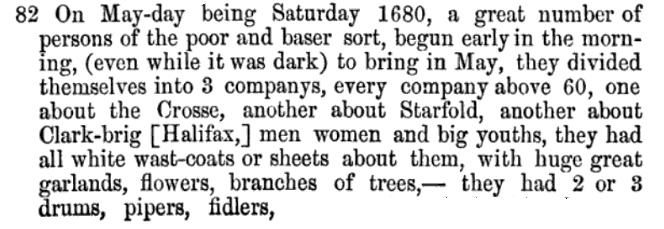 The Rev. Oliver Heywood, B.A., 1630-1702: His Autobiography, Diaries, Anecdote and Event Books; The Rev. Oliver Heywood, B.A., 1630-1702: His Autobiography, Diaries, Anecdote and Event Books;
Illustrating the General and Family History of Yorkshire and Lancashire, Volume 2 page 270 |
| |
| haymaking |
| 1626 poem
“The Pipe and the Tabor is now lustily set on work, and the Lad and Lass will have no lead on their heels:”
1626 'Fantasticks' by Nicholas Breton. He takes the reader through the year, month by month, describing the Christian festivals in turn
and giving a keen insight into the life of country folk. |
1695 in ‘Songs of the West’ by Sabine Baring-Gould
No 109 THE MERRY HAYMAKERS
V1
The golden sun is shining bright,
The dew is off the field;
To us it is our main delight,
The fork and rake to wield.
The pipe and tabor both shall play,
The viols loudly ring,
From morn till eve each summer day,
As we go hay-making.
CHORUS: The pipe and tabor, &c. |
| |
| procession |
1662 Prize Besom of Shaftesbury: the Burgesses of the town ask that the annual procession in May
should not take place on a Sunday.
"The said Mayor, accompanied with some of the Burgesses and other Inhabitants of the said Town and Borough,
have used to walk out into a Place called Enmore−Green, where is a Pool of
Water, and divers Springs and Wells;
and in that Place, to walk or dance Hand in Hand round the same Green in a long Dance, there being a Musician
or Tabor and Pipe, and also a Staffe or Besome adorned with Feathers, Pieces of Gold, Rings and other Jewells,
called a Prize Besom..."
'THE GOD OF THE WITCHES' by
Dr MARGARET ALICE MURRAY, page 93 |
| |
| maypole dancing |
1608 song by by Thomas Weelkes (page 9) English composer and organist
being "noted and famed for a comon drunckard (sic) and notorious swearer & blasphemer"
“Strike it up Tabor and pipe us a favour,
thou shalt be well paid for thy labour:
I mean to spend my shoesole to dance about the Maypole,
I will be blithe and brisk, leap and skip, hop and trip,
turn about in the rout,
until very weary joints can scarce frisk...”
'Ayres of Phantasticke Spirites for three voices' |
Richard Baxter wrote of his childhood, around 1620,
describing what Sunday was like then.
“In the village where I lived, the reader read the common prayer briefly; and the rest of the day…
was spent in dancing under a maypole and a great tree where all the town did meet together…
We could not read the Scripture in our family [because of]
the great disturbance of the tabor and pipe, and noise in the street…” |
| First half of the 17th century:
“…At the Bodleian Library , … , the present writer found the Maypole - dance ( H ); with its primitive
perspective of street - architecture resembling our modern workmen's cottages, and the clear indication
of a prize - wreath for the Queen of the May, with the protecting stumps around the May - pole, and
the Tabourer with his pipe, calling the flat - capped ' Prentice - boys and the blithe damsels to a dancing
- bout . It is apparently of Charles the First's time…” [1600-1649]
1879 commentary on PHILLIP STUBBES'S ANATOMY OF THE ABUSES IN ENGLAND IN SHAKSPERE'S YOUTH , A.D. 1583, page 18 |
|
| 1633
“Mr. Prynn compiled and put in Print a Libelous Volume, Entituled by the name of Histriomastix against
Plays, Masques, Dancings, &c. …Mr. Prynn in his Book hath railed, not only against Stage-Plays, Comedies,
Dancings, and all other Exercises of the People, and against all such as behold them; but farther in particular
against Hunting, Publique Festivals, Christmas-keeping, Bonfires, and May-poles; nay, against the dressing
up of a House with Green-Ivy: and to manifest his evil and mischievous design in publishing of this Libel, he hath
therein written divers incitements, to stir up the People to discontent…”
Lord Chief-Justice Richardson's Sentence:
“…The Woman that singeth in the Dance, is the Prioress of the Devil, and those that answer are Clarks, and the Beholders are the Parishioners, and the Musick are Bells, and the Fidlers are the Minstrels of the Devil….”
John Rushworth, 'Historical Collections: 1633', in Historical Collections of Private Passages of State: Volume 2, 1629-38 (London, 1721) |
1641 'A divine tragedie lately acted, or, A collection of sundrie memorable examples of Gods judgements upon Sabbath-breakers: and other like libertines in their unlawfull sports hapning within the realme of England, in the compasse onely of few yeers last past since the book was published worthy to be known and considered of all men, especially such who are guilty of the sinor arch-patrons thereof
'
by Henry Burton
Example 45, page 20
“Also at Battersey neer London, the last yeer a notable example of Gods judgement befell a fidler,
the youth of the town of both sexes, being assembled solemnly to set up a garland upon their May-pole
and having got a tabor and pipe for the purpose, he with the pipe in his mouth, fell down dead and
never spake word.”
|
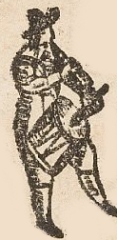 1666 ilustrating a ballad playing for maypole dancing 1666 ilustrating a ballad playing for maypole dancing |
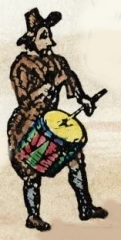 1680's copy 1680's copy |
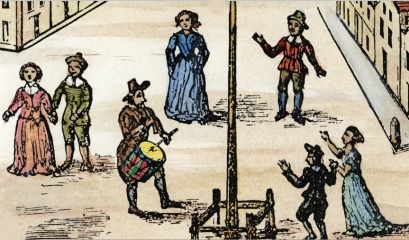 |
|
1671 poem in the Westminster Drollery, called the " Rurall Dance about the May-pole,
the tune the first figure dance at Mr. Young's ball, May 1671'
" Come lasses and lads, take leave of your dads,
And away to the May-pole hie ;
For every he has got him a she,
And the minstrel's standing by.
For Willy has gotten his Jill, and Johnny has got his Joan.
To jig it, jig it, jig it, jig it up and down.
Strike up, says Wat. Agreed, says Kate,
And, I prithee, fidler, play ; ..."
3. Begin sayes Hall,
I, I, sayes Mall,
Wee'l lead up Packintons pound ;
No, no, says Noll,
And so says Doll,
Wee'l first have Sellengers round ;
Then every man began to foot it round about,
And every Girle did jet it, jet it, jet it in and out
4. Y'are out, says Dick,
'Tis a lye, says Nick,
The Fidler playd it false ;
'Tis true, says Hugh,
And so says Sue,
And so says nimble Alice ;
The Fidler then began to play the Tune agen" |
| |
| morris dancing |
| for more cotswold morris dance images and writings go here |
1601 In the play " Iacke Drums Entertainment: or The Comedie of Pasquill and Katherine. As it hath bene sundry times plaide by the Children of Powles. At London, Printed for Richard Oliue...1601. "

" The taber and pipe strike up a morrice. A shoute within :A lord, a lord, a lord, who !
Ed. : Oh, a morrice is come, observe our country sports,
Tis Whitson tyde, and we must frolick it.”

|
| |
| rushbearing |
James I visited Hoghton Tower, Lancashire, in 1617.
It’s recorded that the king rode through an avenue of javelin bearers to be greeted by trumpets and pipers at the tower.
Entertainments included "a rushbearing and pipeing" before the King in the middle court.
Emily V. Cole ‘The State Apartment in the Jacobean Country House, 1603-1625,’ 2010
|
| |
| Ales |
1633 An Order to suppress Ales and Revels in Somersetshire.
'”Whereas divers Orders have been made heretofore by the Judges of Assize, for the suppressing of all
Ales and Revels, the same Order is now confirmed at the Assizes, and again ordered by the Court
in regard of the Infinite Number of Inconveniences, daily arising by means of Revels, that such Revels,
Church-Ales, Clerk-Ales, and all other Publick Ales be henceforth utterly suppressed,…”
John Rushworth, 'Historical Collections: 1633', in 'Historical Collections of Private Passages of State: Volume 2, 1629-38' (London, 1721) |
|
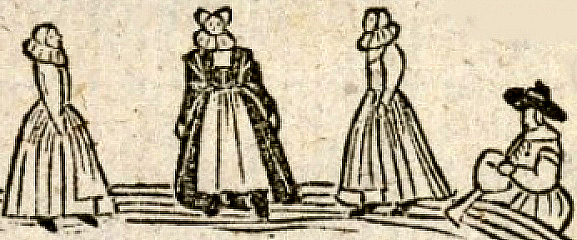 1636 book illustration Cotswold Games
1636 book illustration Cotswold Games  1636 book illustration Cotswold Games
1636 book illustration Cotswold Games